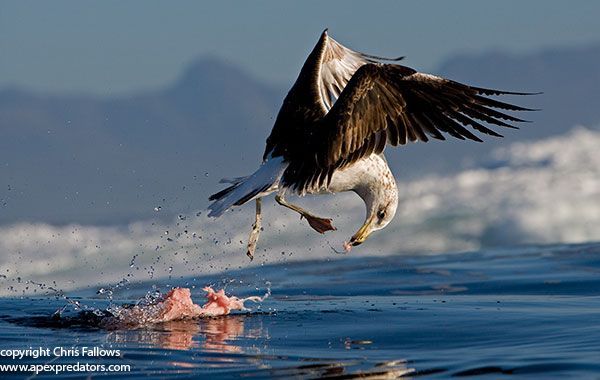
‘The Birds! Suspense and shock beyond anything you have seen or imagined!’ – This is not just a tagline from the famous 1963 film ‘The Birds’ that was directed by Alfred Hitchcock. It is a phrase I hear at Seal Island on a daily basis as we repeatedly shout ‘The birds! The birds are mobile. Where are the birds going?’ I often smile to myself for just a moment as I recall this film and then come swiftly back to the present and the reason we are looking at the birds. To understand and track the predation events occurring at Seal Island as the sun rises overhead.
Seal island is populated by a variety of bird species including three species of cormorant, African penguins and the subject of our cry for ‘the birds’; Black Backed Kelp Gulls. These gulls are the scavengers of the island and can regularly be seen in association with the sharks’ predation events. They congregate at the south western part of the island and watch the surrounding waters for signs of events to be investigated as the sharks hunt.
I have come to know these gulls well during the season and their importance in allowing us to identify predation events. The gulls are quick to identify an event as it is occurring and leave the island in their numbers as they hope for a free meal. They fly high above the ocean to observe an event if they are unsure whether there has been a kill and require further information. In contrast, they fly low and close to the water when they know there has been a kill and move swiftly and directly to the site. Upon arrival, the gulls congregate in a flurry of movement and wings above the predation event and act as an obvious and easily identifiable marker for us. This grouping allows us to locate the events from great distances and move closer to observe.
You can understand where our call ‘The birds! The birds are mobile. Where are the birds going?’ comes into play. We either track their movements towards an event or identify the group of birds wheeling overhead as an event unfolds. When there has been a kill, the gulls then touch down on the water as they swoop and jostle for morsels of seal. Some of them continue to fly and track the shark moving just below the surface of the water whilst it consumes its kill. This is also useful behaviour for us because it allows us to locate the shark below the gulls, giving our guests the opportunity to watch the magnificent shark when it surfaces.
So not only do these gulls pinpoint where a predation even is occurring. They also allow us to identify when it has become a successful kill and locate the shark moving underwater. I am beginning to wonder if the gulls should be on the pay roll and added to the Apex staff list for their efforts.







